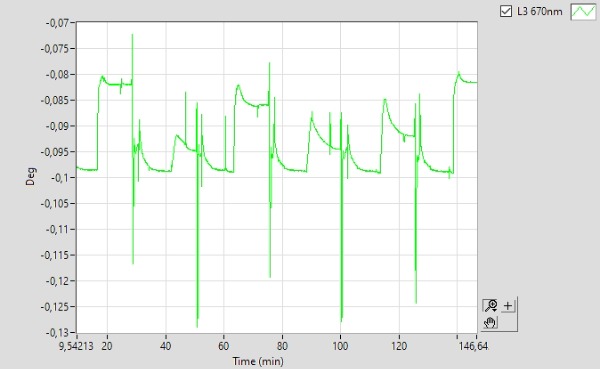This forum is intended for questions about kinetics, Surface Plasmon Resonance and the instruments related to these techniques.
Interaction changes with lipids
- migarpo
- Topic Author
- New Member
-

Less
More
- Thank you received: 0
3 years 5 months ago #1
by migarpo
Interaction changes with lipids was created by migarpo
Hi all,
I am working with planar membrane chips and I am finding hard to have a good fitting.
In the first image there is a good 1 to 1 fitting of my protein, a Fab (arm of an antibody) (48KDa) attaching to a peptide in HBS.100ul/min. But when the peptide is embeded in a llipid membrane, the model is far from 1 to1. (fig 2). Also, if we look at the whole sensogram, it seems like the more protein I use, the more it gets attached to the membrane and won't dissociate.
So my questions are:
[/ul]Do you think, the curves are just bad, or there can be a bivalent interaction? lipid may affect the binding angle, and as usual, one to two fits well.
Looking at the whole sensogram, can I expect a normal one to one interaction?
I thank Arnoud for your support and encourage any other who works with lipids to write his experience too.
Regards
Miguel
I am working with planar membrane chips and I am finding hard to have a good fitting.
In the first image there is a good 1 to 1 fitting of my protein, a Fab (arm of an antibody) (48KDa) attaching to a peptide in HBS.100ul/min. But when the peptide is embeded in a llipid membrane, the model is far from 1 to1. (fig 2). Also, if we look at the whole sensogram, it seems like the more protein I use, the more it gets attached to the membrane and won't dissociate.
So my questions are:
[/ul]Do you think, the curves are just bad, or there can be a bivalent interaction? lipid may affect the binding angle, and as usual, one to two fits well.
Looking at the whole sensogram, can I expect a normal one to one interaction?
I thank Arnoud for your support and encourage any other who works with lipids to write his experience too.
Regards
Miguel
Please Log in or Create an account to join the conversation.
- Arnoud
- Moderator
-

Less
More
- Thank you received: 0
3 years 5 months ago #2
by Arnoud
Replied by Arnoud on topic Interaction changes with lipids
Hi Miguel,
Please try to upload your figures ( www.sprpages.nl/kunena/new-forum/73-how-...n-image-to-your-post ).
Arnoud
Please try to upload your figures ( www.sprpages.nl/kunena/new-forum/73-how-...n-image-to-your-post ).
Arnoud
Please Log in or Create an account to join the conversation.
- migarpo
- Topic Author
- New Member
-

Less
More
- Thank you received: 0
3 years 5 months ago #3
by migarpo
Replied by migarpo on topic Interaction changes with lipids
Please Log in or Create an account to join the conversation.
- Arnoud
- Moderator
-

Less
More
- Thank you received: 0
3 years 5 months ago #4
by Arnoud
Replied by Arnoud on topic Interaction changes with lipids
Hi Miguel,
The first fitting shows this buffer jump which is best visible between association and dissociation. This is a sign that the interaction is not entirely 1:1. Options to reduce non-ideal interaction are immobilizing less peptide and using pure analyte. The flow is already high. The second fitting is like the first although the dissociation is fitting less accurate. Also here, lowering the amount of peptide in the membrane can make the kinetics better. Do you use a reference like a membrane surface without peptide? This can help you to identify if the Fab is binding to the lipids of the membrane. Maybe you can alter the buffer (type, salt concentration and pH) to optimize the interaction. Most people stick to HBS but PBS or Tris is worth a try.
Kind regards
Arnoud
The first fitting shows this buffer jump which is best visible between association and dissociation. This is a sign that the interaction is not entirely 1:1. Options to reduce non-ideal interaction are immobilizing less peptide and using pure analyte. The flow is already high. The second fitting is like the first although the dissociation is fitting less accurate. Also here, lowering the amount of peptide in the membrane can make the kinetics better. Do you use a reference like a membrane surface without peptide? This can help you to identify if the Fab is binding to the lipids of the membrane. Maybe you can alter the buffer (type, salt concentration and pH) to optimize the interaction. Most people stick to HBS but PBS or Tris is worth a try.
Kind regards
Arnoud
Please Log in or Create an account to join the conversation.
- migarpo
- Topic Author
- New Member
-

Less
More
- Thank you received: 0
3 years 5 months ago #5
by migarpo
Replied by migarpo on topic Interaction changes with lipids
Yes, I use a reference channel with lipid alone. The figure of the total sensogram is after substracting the lipid channel component, that is why I don't understand why I have a fast and then a slow dissociation.
Maybe as you say, it is an artifact due to too much peptide.
Thanks for your advice.
Miguel
Maybe as you say, it is an artifact due to too much peptide.
Thanks for your advice.
Miguel
Please Log in or Create an account to join the conversation.
- Sengupta
- New Member
-

Less
More
- Thank you received: 0
3 years 1 month ago #6
by Sengupta
Replied by Sengupta on topic Interaction changes with lipids
Hi Miguel,
Wondering if you are using a Nicoya system and liposome sensor.
Sonali
Wondering if you are using a Nicoya system and liposome sensor.
Sonali
Please Log in or Create an account to join the conversation.
Moderators: Arnoud, Arnoud
